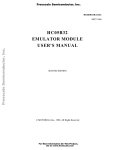Download M68EM05P3 MANUAL
Transcript
M68HC05P3EM/D Rev. 1 August 1994 HC05P3 EMULATOR MODULE USER'S MANUAL Second Edition © MOTOROLA Inc., 1994; All Rights Reserved M68HC05P3EM/D 3-1 MOTOROLA Motorola reserves the right to make changes without further notice to any products herein to improve reliability, function, or design. Motorola does not assume any liability arising out of the application or use of any product or circuit described herein; neither does it convey any license under its patent rights nor the rights of others. Motorola products are not designed, intended, or authorized for use as components in systems intended for surgical implant into the body, or other application in which the failure of the Motorola product could create a situation where personal injury or death may occur. Should Buyer purchase or use Motorola products for any such unintended or unauthorized application, Buyer shall indemnify and hold Motorola and its officers, employees, subsidiaries, affiliates, and distributors harmless against all claims, costs, damages, and expenses, and reasonable attorney fees arising out of, directly or indirectly, any claim of personal injury or death associated with such unintended or unauthorized use, even if such claim alleges that Motorola was negligent regarding the design or manufacture of the part. Motorola and the Motorola logo are registered trademarks of Motorola Inc. Motorola Inc. is an Equal Opportunity/Affirmative Action Employer. M68HC05P3EM/D 3-2 MOTOROLA CONTENTS C H A P TER 1 I N T R O D U C T I O N ................................ ................ 1-1 1 . 1 D e v e l o p m e n t S y s t e m s ................................ .......................... 1.1.1 M o t o r o l a M o d u l a r D e v e l o p m e n t S y s t e m ( M M D S 0 5 ) ................ 1.1.2 M 6 8 H C 0 5 E V S E v a l u a t i o n S y s t e m ( H C 0 5 E V S ) ...................... 1 . 2 E M L a y o u t ................................ ................................ ...... 1 . 3 C o n n e c t o r P 4 P i n A s s i g n m e n t s ................................ ............... 1-1 1-1 1-2 1-3 1-4 C H A P TER 2 M M D S 0 5 C O N F I G U R A T I O N A N D O P E R A T I O N ........ 2-1 2 . 1 S e t t i n g P 3 E M J u m p e r H e a d e r s ................................ ................. 2 . 1 . 1 C l o c k S o u r c e S e l e c t H e a d e r s ( J 1 a n d J 2 ) ............................... 2 . 1 . 2 R e s e t S e l e c t H e a d e r ( J 3 ) ................................ ................. 2 . 1 . 3 R e s i d e n t M C U S e l e c t H e a d e r ( J 4 ) ................................ ....... 2 . 2 T h e E m u l a t e d M C U ................................ ............................. 2 . 2 . 1 P 3 E m u l a t i o n ................................ .............................. 2 . 2 . 2 7 0 5 P 3 E m u l a t i o n ................................ .......................... 2 . 3 R e m a i n i n g S y s t e m I n s t a l l a t i o n ................................ ................. 2-1 2-2 2-3 2-3 2-4 2-4 2-4 2-5 C H A P TER 3 H C 0 5 E V S C ON F I G U R A T I ON A N D OP E R A T I ON . . . . . 3 - 1 3 . 1 S e t t i n g P 3 E M J u m p e r H e a d e r s ................................ ................. 3 . 1 . 1 C l o c k S o u r c e S e l e c t H e a d e r s ( J 1 a n d J 2 ) ............................... 3 . 1 . 2 R e s e t S e l e c t H e a d e r ( J 3 ) ................................ ................. 3 . 1 . 3 R e s i d e n t M C U S e l e c t H e a d e r ( J 4 ) ................................ ....... 3 . 2 T h e E m u l a t e d M C U ................................ ............................. 3 . 2 . 1 P 3 E m u l a t i o n ................................ .............................. 3 . 2 . 2 7 0 5 P 3 E m u l a t i o n ................................ .......................... 3 . 3 E V S L i m i t a t i o n s ................................ ................................ . 3 . 4 L o g i c A n a l y z e r C o n n e c t o r P 1 ................................ .................. 3 . 5 R e m a i n i n g S y s t e m I n s t a l l a t i o n ................................ ................. M68HC05P3EM/D 3-3 3-1 3-2 3-3 3-3 3-4 3-4 3-4 3-5 3-6 3-8 MOTOROLA FIGURES Figure Page 1-1 1-2 H C 0 5 P 3 E m u l a t o r M o d u l e ................................ ................... C o n n e c t o r P 4 P i n A s s i g n m e n t s ................................ .............. 1-3 1-5 3-1 C o n n e c t o r P 1 P i n A s s i g n m e n t s ................................ 3-6 .............. TABLES Table Page 2-2 M C U s a n d P e r s o n a l i t y F i l e s ................................ 3-1 3-2 R e s i d e n t M C U s ................................ ................................ L o g i c A n a l y z e r C o n n e c t o r P 1 S i g n a l D e s c r i p t i o n s ......................... M68HC05P3EM/D 3-4 .................. 2-4 3-4 3-7 MOTOROLA CHAPTER 1 INTRODUCTION This user's manual explains connection, configuration, and operation information specific to the HC05P3EM Emulator Module (P3EM). The P3EM makes possible emulation and debugging of target systems based on these microcontroller units (MCUs): MC68HC05P3 MC68HC705P3 The P3EM can be part of two development systems. This chapter describes those systems and explains the layout of the P3EM. 1.1 DEVELOPMENT SYSTEMS Your P3EM can be part of two Motorola development tools: the HC05 Motorola Modular Development System (MMDS05) or the M68HC05EVS Evaluation System (HC05EVS). 1.1.1 Motorola Modular Development System (MMDS05) The MMDS05 is an emulator system that provides a bus state analyzer and real-time memory windows. The unit's integrated design environment includes an editor, an assembler, user interface, and source-level debug. A complete MMDS05 consists of: • a station module — the metal MMDS05 enclosure, containing the control board and the internal power supply. Most system cables connect to the MMDS05 station module. (The cable to an optional target system, however, runs through an aperture in the station module enclosure to connect directly to the emulator module.) • an emulator module (EM) — such as the P3EM: a printed circuit board that enables system functionality for a specific set of MCUs. The EM fits into the station module through a sliding panel in the enclosure top. The EM has a connector for the target cable. M68HC05P3EM/D 3-5 MOTOROLA • two logic clip cable assemblies — twisted-pair cables that connect the station module to your target system, a test fixture, a clock, or any other circuitry useful for evaluation or analysis. One end of each cable assembly has a molded connector, which fits into station-module pod A or pod B. Leads at the other end of each cable terminate in female probe tips. Ball clips come with the cable assemblies. • a 9-lead RS-232 serial cable — the cable that connects the station module to the host computer RS-232 port. • a 9- to 25-pin adapter — a molded assembly that lets you connect the 9-lead cable to a 25-pin serial port. • system software — software, on 3-1/2 inch diskettes. • MMDS05 documentation — an MMDS05 operations manual (MMDS05OM/D) and the appropriate EM user's manual. As mentioned, your P3EM gives the MMDS05 the ability to emulate the MC68HC(7)05P3 MCU(s). By substituting a different EM, you can enable your MMDS05 to emulate an MCU of a different series. (Your Motorola representative can explain all the EMs available.) Chapter 2 explains how to configure and use your P3EM as part of an MMDS05 system. For information about MMDS05 software or the station module, see the MMDS05 operations manual. For layout and configuration information pertaining to a different EM, see the corresponding EM user's manual. 1.1.2 M68HC05EVS Evaluation System (HC05EVS) An HC05EVS is an economical, two-board tool for designing, debugging, and evaluating target systems based on an MC68HC05 MCU. A complete HC05EVS consists of: • a platform board (PFB) — the bottom board, which supports the emulator module. The platform board has connectors for power and for the terminal or host computer. • an emulator module (EM) — such as the P3EM: a printed circuit board that enables system functionality for a specific set of MCUs. The EM fits onto the PFB. The EM has connectors for a target cable and for a cable to a logic analyzer. • an RS-232 serial cable — the cable that connects the PFB to the host computer RS232 port. • system software — software, on 3-1/2 inch diskettes. • HC05EVS documentation — an HC05EVS operations manual (HC05EVSOM/D) and the appropriate EM user's manual. As mentioned, your HC05P3 EVS emulates the MC68HC(7)05P3 MCU(s). By substituting a different EM, you can enable your HC05EVS to emulate an MCU of a different series. (Your Motorola representative can explain all the EMs available.) Chapter 3 explains how to configure and use your P3EM as part of an HC05EVS system. For information about HC05EVS software or the platform board, see the HC05EVS operations manual. For layout and configuration information pertaining to a different EM, see the corresponding EM user's manual. M68HC05P3EM/D 3-6 MOTOROLA 1.2 EM LAYOUT Figure 1-1 shows the layout of the P3EM. Jumper headers J1 and J2 let the user select the clock source; on board oscillator, target oscillator or MMDS05 oscillator. Note that the target oscillator requires a single clock supply, it is not suitable to connect a crystal external to the EM board. Jumper J3 determines the logic direction of the RESET signal at the target connector. Jumper J4 selects the correct sense of the CPU LIR signal depending on the resident MCU. Connector P4 is the interface to a target system. This connector can either use a separately supplied target cable from Motorola or a user-supplied ribbon cable to DIP head. If you install the P3EM in the MMDS05 station module, the target cable passes through the slit in the station module enclosure. Connector P1 connects to a logic analyzer. (Connector P1 has more significance for an EVS system, as an MMDS05 system includes a bus analyzer.) Expansion header connectors P2 and P3 connect together the EM and the control board (for an MMDS05) or the EM and the platform board (for an EVS). P1 P2 J1 J2 1 1 P3 P4 J3 1 MC68HC(7)05P3 J4 1 Figure 1-1. HC05P3 Emulator Module M68HC05P3EM/D 3-7 MOTOROLA 1.3 CONNECTOR P4 PIN ASSIGNMENTS Figure 1-2 shows the pin assignments for connector P4. The italic numbers correlate the P4 pins with the pins of your MCU. For signal descriptions, consult the technical data book for the specific MCU. P4 GND Vdd Detect PA0 PA1 PA2 PA3 PA4 PA5 PA6 PA7 PC0/TCAP PC1/TCMP PC2 PC3 GND GND GND GND GND GND 1 3 5 7 9 11 13 15 17 19 21 23 25 27 29 31 33 35 37 39 2 4 6 8 10 12 14 16 18 20 22 24 26 28 30 32 34 36 38 40 IRQ* RESET* OSC1 NC PB7 PB6 PB5 PB4 PB3 PB2 PB1 PB0 PC5 PC4 GND GND GND GND GND GND Figure 1-2. Connector P4 Pin Assignments As connector P1 has more importance to an HC05EVS than to an MMDS05, pin assignments for connector P1 are in Chapter 3. To configure your P3EM for use as part of an MMDS05, follow the instructions of Chapter 2. To configure your P3EM for use as part of an HC05EVS, follow the instructions of Chapter 3. M68HC05P3EM/D 3-8 MOTOROLA CHAPTER 2 MMDS05 CONFIGURATION AND OPERATION This chapter explains how to configure and use your P3EM as part of an MMDS05. For other parts of system installation or configuration, see the MMDS05 operations manual (MMDS05OM/D). (If you will use your P3EM as part of an HC05EVS system, go to Chapter 3 for corresponding information.) Paragraph 2.1 explains how to set P3EM jumper headers. Paragraph 2.2 explains considerations pertaining to the MCU you emulate. Paragraph 2.3 explains remaining system installation. Note that you can configure a P3EM already installed in the MMDS05 station module enclosure. To do so, switch off station-module power, remove the panel, then follow the guidance of this chapter. CAUTION Be sure to switch off power if you reconfigure an installed EM. Reconfiguring EM jumper headers with power left on can damage MMDS05 circuits. 2.1 SETTING P3EM JUMPER HEADERS Your P3EM has four jumper headers, J1 through J4. Paragraphs 2.1.1., 2.1.2. and 2.1.3 explain how to configure these headers. M68HC05P3EM/D 3-9 MOTOROLA 2.1.1 Clock Source Select Headers (J1 and J2) Jumper headers J1 and J2 determine the source of the clock signal. The diagram below shows the factory configuration: the fabricated jumpers select the P3EM canned oscillator clock source. FABRICATED JUMPERS J1 1 J2 (J2) 1 (2) (3) TRGT (2) XTAL (3) MMDS Alternatively, you may use a clock source originating from the control board. To do so, reposition the J1 jumper between pins 1 and 2, then use the MMDS05 OSC command to select a frequency. To use a clock source originating from the target system reposition the J3 jumper between pins 1 and 2. M68HC05P3EM/D 3-10 MOTOROLA 2.1.2 Reset Select Header (J3) Jumper header J3 controls the path of a target reset. The diagram below shows the factory configuration: the fabricated jumper between pins 1 and 2 enables your software to control resets. This is the only correct J3 configuration for a P3EM that is part of an MMDS05. FABRICATED JUMPER J3 EVS 1 (2) TRGT (3) NOTE The J3 pins 2-and-3 configuration is not correct for a P3EM that is part of an MMDS05 system. Such a configuration would interfere with correct operation of the RESETIN and RESETOUT commands. 2.1.3 Resident MCU Select Header (J4) Jumper header J4 selects the correct EM operation for each of the possible resident MCUs. The diagram below shows the factory configuration: the fabricated jumper between pins 2 and 3 selects the correct LIR operation for an MC68HC705P3. Reposition the jumper between pins 1 and 2 when an MC68HC05P3 MCU adaptor assembly is installed in socket U2. FABRICATED JUMPER J4 1 05P3 (2) (3) M68HC05P3EM/D 705P3 3-11 MOTOROLA 2.2 THE EMULATED MCU Your MMDS05 system uses a specific personality file for the MCU type being emulated. For example, to emulate an MC68HC05P3 or MC68HC705P3 MCU, the system uses personality file 00207Vxx.MEM. Table 2-1 lists the personality files that pertain to the P3EM. Note that personality file names follow the pattern 00ZZZVxx.MEM, where ZZZ is the EM identifier or MCU name, and xx is the version of the file. Table 2-1. MCUs and Personality Files EMULATED MCU PERSONALITY FILE COMMENTS M68HC05P3 00207V01.MEM See paragraph 2.2.1 M68HC705P3 00207V01.MEM See paragraph 2.2.2. MMDS05 software loads the personality file upon powerup. To replace the default personality file with a different one, use the LOADMEM command. (For more information about the LOADMEM command, see the explanation in the MMDS05 operations manual.) Alternatively, you can insert the line LOADMEM 00ZZZVxx.MEM in the STARTUP.05 script file. This way, the system automatically loads the specified personality file as part of system startup. (For more information about the STARTUP.05 script file, see the SCRIPT command explanation in the MMDS05 operations manual.) 2.2.1 P3 Emulation To emulate an MC68HC05P3 use the MC68HC705P3 for the resident MCU. The installed 705P3 allows the user to select COP and IRQ mask options under software control. These selections are mask programmable in the MC68HC05P3. See the online CHIPINFO (MMDS05only), or the appropriate data book for further information. To replace the supplied MC68HC705P3 device with an MC68HC05P3 device a Motorola supplied adaptor is required. Do not attempt to insert an MC68HC05P3 device directly into socket U2. 2.2.2 705P3 Emulation The MC68HC705P3 MCU contains additional registers to allow programming of the internal EPROM and selection of mask options. An M68HC05P3 device does not support these features. M68HC05P3EM/D 3-12 MOTOROLA 2.3 REMAINING SYSTEM INSTALLATION When you have configured headers J1 through J4, you are through with P3EM configuration: • To install the P3EM in an MMDS05 station module, remove the panel from the stationmodule top. Fit together EM connectors P2 and P3 (on the bottom of the board) and control-board connectors P11 and P12. Snap the corners of the EM onto the plastic standoffs. Connect the target cable, if appropriate. Replace the panel. • If your P3EM already is installed in the station module, reconnect the target cable (if necessary). Replace the panel. At this point, you are ready to make remaining cable connections, as necessary, and restore power. For instructions, consult the MMDS05 operations manual (MMDS05OM/D). M68HC05P3EM/D 3-13 MOTOROLA THIS PAGE LEFT BLANK INTENTIONALLY M68HC05P3EM/D 3-14 MOTOROLA CHAPTER 3 HC05EVS CONFIGURATION AND OPERATION This chapter explains how to configure your P3EM for use as part of an HC05EVS. For other parts of system installation or configuration, see the HC05EVS operations manual (HC05EVSOM/D). (If you will use your P3EM as part of an MMDS05 system, go to Chapter 2 for configuration information.) Paragraph 3.1 explains how to set P3EM jumper headers. Paragraph 3.2 explains considerations pertaining to the MCU you emulate. Paragraph 3.3 lists limitations on using the P3EM in an HC05EVS. Paragraph 3.4 explains pin assignments and signal descriptions for the logic analyzer connector (P1). Paragraph 3.5 explains remaining system configuration. Note that you can configure a P3EM already installed on the HC05EVS platform board. To do so, disconnect platform-board power, then follow the guidance of this chapter. CAUTION Be sure to disconnect power if you reconfigure an installed EM. Reconfiguring EM jumper headers with power left on can damage HC05EVS circuits. 3.1 SETTING P3EM JUMPER HEADERS Your P3EM has four jumper headers, J1 through J4. Paragraphs 3.1.1. through 3.1.3 explain how to configure these headers. M68HC05P3EM/D 3-15 MOTOROLA 3.1.1 Clock Source Select Headers (J1 and J2) Jumper headers J1 and J2 determines the source of the clock signal. The diagram below shows the factory configuration: the fabricated jumpers select the P3EM canned oscillator clock source. To use a clock source originating from the target system reposition the J1 jumper between pins 1 and 2 and the J2 jumper between pins 1 and 2. FABRICATED JUMPERS J1 1 J2 (J2) 1 (2) (3) TRGT (2) XTAL (3) MMDS NOTE The J2 pins 2-and-3 configuration is not correct for a P3EM that is part of an HC05EVS system. M68HC05P3EM/D 3-16 MOTOROLA 3.1.2 Reset Select Header (J3) Jumper header J3 controls the path of a target reset. The diagram below shows the factory configuration: the fabricated jumper between pins 1 and 2 enables your P3EVS to reset the target when you press the user or master reset switch. FABRICATED JUMPER J3 EVS 1 (2) TRGT (3) Alternatively, you may enable the target system to reset the P3EVS. To do so: • Reposition the P3EM J3 jumper between pins 2 and 3, and • Insert a fabricated jumper into platform-board header J3. 3.1.3 Resident MCU Select Header (J4) Jumper header J4 selects the correct EM operation for each of the possible resident MCUs. The diagram below shows the factory configuration: the fabricated jumper between pins 2 and 3 selects the correct LIR operation for an MC68HC705P3. Reposition the jumper between pins 1 and 2 when an MC68HC05P3 MCU adaptor assembly is installed in socket U2. FABRICATED JUMPER J4 1 05P3 (2) (3) M68HC05P3EM/D 705P3 3-17 MOTOROLA 3.2 THE EMULATED MCU The MCU device at P3EM location U2 contains the resident MCU. The factory ships the P3EM with an MC68HC705P3 resident MCU, which is appropriate for emulating a number of MCUs with some qualifications as described in the following paragraphs 3. Table 3-1. Resident MCUs EMULATED MCU resident mcu comments M68HC05P3 M68HC05P3 See paragraph 3.2.1 M68HC705P3 M68HC05P3 See paragraph 3.2.2. Table 3-1 shows the resident MCU appropriate for your emulation with additional information in the reference paragraphs. Also note paragraph 3.2.2 below, for the information specific to the MCU you emulate. 3.2.1 P3 Emulation To emulate an MC68HC05P3 use the MC68HC705P3 for the resident MCU. The installed 705P3 allows the user to select COP and IRQ mask options under software control. These selections are mask programmable in the MC68HC05P3. See the appropriate data book for further information. To replace the supplied MC68HC705P3 device with an MC68HC05P3 device a Motorola supplied adaptor is required. Do not attempt to insert an MC68HC05P3 device directly into socket U2. 3.2.2 705P3 Emulation The MC68HC705P3 MCU contains additional registers to allow programming of the internal EPROM and selection of mask options. An M68HC05P3 device does not support these features. M68HC05P3EM/D 3-18 MOTOROLA 3.3 EVS LIMITATIONS This paragraph explains the limitations that apply to using your P3EM in an HC05EVS. (These limitations, except 5, apply regardless of the resident MCU.) Limitation 1. CLI/RTI. You may not trace a clear interrupt mask (CLI) or return from interrupt (RTI) instruction with an interrupt enabled and pending, due to MCU interrupt handling. Attempting such a trace causes an interrupt in the monitor map; this forces a software reset of the HC05EVS. User breakpoints remain in the user map as SWI instructions; you must remove such SWI instructions. Limitation 2. Branch. Do not trace a conditional branch instruction (such as BRCLR) that branches to itself. As the monitor places an SWI instruction on the object of the branch, the system never would execute the instruction. However, it would appear to you that the instruction had executed. You may enter a G command while the PC points to this type of instruction as long as the instruction is not a breakpoint address. Limitation 3. IRQ/SWI. Whenever possible, avoid mixing interrupt requests (IRQs) and user software interrupts (SWIs). This prevents a possible IRQ-SWI timing problem: a concurrent hardware interrupt and SWI could cause an HC05EVS failure that could stop program execution. To recover from such a failure (which occurs very infrequently, statistically), press the master reset switch (SW3). Limitation 4. Memory Map. You must be aware of the memory map of the MCU being simulated; be sure to use only valid ROM locations. The HC05EVS does not provide protection to limit user programs to the exact amount of MCU ROM available. (For information about memory maps, consult the technical data book for the MCU.) Limitation 5. COP. The resident MCU installed on the P3EM does not support COP operation. To emulate the COP function please contact Motorola for further information. M68HC05P3EM/D 3-19 MOTOROLA 3.4 LOGIC ANALYZER CONNECTOR P1 Figure 3-1 shows the pin assignments for logic analyzer connector P1. Table 3-2 lists signal descriptions for this connector. P1 NC NC LA11 LA10 LA9 LA8 LA7 LA6 LA5 LA4 LA3 LA2 LA1 LA0 LR/W NC NC NC VCC RESET 1 3 5 7 9 11 13 15 17 19 21 23 25 27 29 31 33 35 37 39 2 4 6 8 10 12 14 16 18 20 22 24 26 28 30 32 34 36 38 40 GND NC GND NC NC NC NC AD7 AD6 AD5 AD4 AD3 AD2 AD1 AD0 LIR NC NC E NC Figure 3-1. Connector P1 Pin Assignments M68HC05P3EM/D 3-20 MOTOROLA Table 3-2. Logic Analyzer Connector P1 Signal Descriptions PIN MNEMONIC SIGNAL 1, 3, 4, 8, 10, 12, 14, 31, 33 — 36, 40 ----- No connection 2, 6 GND GROUND 5, 7, 9, 11. 13. 15. 17, 19, 21, 23, 25, 27 LA11 — LA0 LATCHED ADDRESSES (bits 11—0) - MCU latched output address bus. 16, 18, 20, 22, 24, 26, 28, 30 AD7 — AD0 29 LR/W LATCHED READ/WRITE - Active-high output signal that indicates the direction of data transferred on the bus. 32 LIR LOAD INSTRUCTION REGISTER - Open-drain, active-low output signal that indicates an instruction is starting. 37 VCC +5 VDC POWER - Input voltage (+5 Vdc @ 1.0 A) used by EVS logic circuits. 38 E 39 RESET M68HC05P3EM/D DATA BUS (bits 7—0) - MCU multiplexed I/O data bus. EXTERNAL CLOCK - Internally generated output clock signal used as a timing reference. The frequency of E clock is 1/2 the input frequency of the signal on the OSC2 pin. RESET - Active-low bidirectional signal for starting an EVS reset. 3-21 MOTOROLA 3.5 REMAINING SYSTEM INSTALLATION When you have configured headers J1 through J4, you are through with P3EM configuration. Find jumper header J1 of the HC05EVS platform board. jumpers are installed, per the diagram below. Make sure that two fabricated J1 A14 1 2 A13 3 4 A12 5 6 A11 7 8 FABRICATED JUMPER To install the P3EM on an HC05EVS platform board, fit together EM connectors P2 and P3 (on the bottom of the board) and platform-board connectors P3 and P4. Snap the corners of the EM onto the plastic standoffs. At this point, you are ready to make remaining cable connections, as necessary, and restore power. For instructions, consult the HC05EVS operations manual (HC05EVSOM/D). M68HC05P3EM/D 3-22 MOTOROLA




































